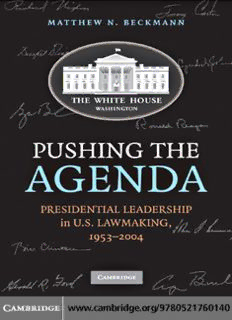
Pushing the Agenda: Presidential Leadership in US Lawmaking, 1953-2004 PDF
Preview Pushing the Agenda: Presidential Leadership in US Lawmaking, 1953-2004
This page intentionally left blank PUSHINGTHEAGENDA Today’spresidentsenterofficehavingcampaignedonanambitiouspolicy agenda,eagertoseeitenacted,andwillingtopushsothatitis.Thecen- tralquestionofpresidents’legislativeleadership,therefore,isnotaques- tion of resolve but a question of strategy: By what means can presidents build winning coalitions for their agenda? Pushing the Agenda uncovers theanswer.Itrevealsthesystematicstrategiespresidentsemploytoinflu- ence Congress and the conditions that determine when those strategies work–ordon’t.Drawingonaneclecticarrayoforiginalevidence–span- ning presidentsfromDwight Eisenhowerto George W. Bush – Matthew N.Beckmannfindsthatmodernpresidents’influenceinCongressisreal, oftensubstantial,and,todate,largelyunderestimated. Matthew N. Beckmann is Assistant Professor of political science at the University of California, Irvine, where he studies Washington politics, particularly those involving the White House. His work has appeared in the Journal of Politics, theJournal of Theoretical Politics, Political Research Quarterly, and Political Communication. Professor Beckmann received his BAfromtheUniversityofCalifornia,LosAngeles,andhisPhDfromthe UniversityofMichigan. “Acriticalpartofthenewgenerationofpresidencyresearch,Matthew Beckmann’sPushingtheAgendatakescomplexformalandinformalthe- oriesseriouslyandthenasks,‘isthisreallyhowpresidentialinfluence works?’ His distinction between endgame, where votes matter most, and‘earlygame,’wherecooperationoveragendasmattersmost,con- stitutesanoriginaltheoreticaswellasempiricalcontributionthataca- demicsineverysettingwillbegintotakeupintheirownresearch.His analysisofpresidential‘influence’withinthesetwocontextsbreathes newlifeintoatraditionalconceptrenderedmoribundbytwodecades of identification with measures of ‘voting success’ by demonstrating that when agendas matter and when votes matter, presidents matter andnotatthemarginseither,butatthecore.Thisbookrepresentsa foundationonwhichtoconstructanewgenerationofunderstanding andrelevancyforpresidencyresearch.” –TerrySullivan,HooverInstitution,StanfordUniversity, andUniversityofNorthCarolinaatChapelHill “MatthewBeckmann’sPushingtheAgenda:PresidentialLeadershipinU.S. Lawmaking, 1953–2004, is a major contribution to our knowledge aboutpresidentiallegislativepower.Heusesrichandinnovativequan- titative and qualitative analysis of the last half-century’s presidential- congressional interactions to explain presidential power on the Hill. Hiswell-writtenanduniqueanalysisfocusesonpresidentialstrategies andsuccessesandfailuresofpresidentialinfluenceinCongress.Itis amust-readforanyoneinterestedinthepresidencyandCongress.” –JamesA.Thurber,AmericanUniversity Pushing the Agenda Presidential Leadership in U.S. Lawmaking, 1953–2004 Matthew N. Beckmann UniversityofCalifornia,Irvine CAMBRIDGEUNIVERSITYPRESS Cambridge, New York, Melbourne, Madrid, Cape Town, Singapore, São Paulo, Delhi, Dubai, Tokyo Cambridge University Press The Edinburgh Building, Cambridge CB2 8RU, UK Published in the United States of America by Cambridge University Press, New York www.cambridge.org Information on this title: www.cambridge.org/9780521760140 © Matthew N. Beckmann 2010 This publication is in copyright. Subject to statutory exception and to the provision of relevant collective licensing agreements, no reproduction of any part may take place without the written permission of Cambridge University Press. First published in print format 2010 ISBN-13 978-0-511-71259-3 eBook (NetLibrary) ISBN-13 978-0-521-76014-0 Hardback ISBN-13 978-0-521-16291-3 Paperback Cambridge University Press has no responsibility for the persistence or accuracy of urls for external or third-party internet websites referred to in this publication, and does not guarantee that any content on such websites is, or will remain, accurate or appropriate. Contents Figures pagevii Tables ix Acknowledgments xi 1 Introduction 1 2 ATheoryofPositivePresidentialPower 27 3 CaseStudy:PushingPresidentBush’s2001TaxCut 68 4 WinningKeyVotes,1953–2004 106 5 SigningNewLaws,1953–2004 128 6 ThePracticeandPotentialofPresidentialLeadership 150 Appendix: ArchivalStudyTechnicalDetails 163 References 177 Index 187 v Dedicatedtomyparents,BobandMaryLou Figures 1.1 ThePivotalPoliticsModelofLawmaking page8 1.2 Presidents’LegislativeInfluenceviaAgendaSetting 19 1.3 Presidents’LegislativeInfluenceviaLobbying 22 2.1 AModelofLawmaking 30 2.2 ImplicationsoftheLegislativeEndgame 32 2.3 FilibusterPivotsintheEighty-Third(1953–54)and Eighty-Sixth(1959–60)Congresses 35 2.4 RangeofPotentiallyPassablePoliciesforDifferent StatusQuos 38 2.5 Presidents’andSupportiveLeaders’Preferences 39 2.6 TheBasicPolicymakingGameunderUnifiedand DividedGovernment(withClosedRules) 43 2.7 AModelofLawmakingwithPresidentialLobbying 46 2.8 Vote-CenteredLobbying 48 2.9 PresidentialInfluenceviaVote-CenteredLobbying 49 2.10 Agenda-CenteredLobbying 56 2.11 PresidentialInfluenceviaAgenda-Centeredand Vote-CenteredLobbying 60 3.1 HouseofRepresentativesPreferenceDistribution, 107thCongress 77 3.2 U.S.SenatePreferenceDistribution,107thCongress 78 3.3 Senators’PreferenceDistribution,inSampleandTotal 87 3.4 SourcesofAdministration’sLobbyingContacts,2001 TaxCutDebate 92 3.5 LocationsofPresidentBush’s“Going-Public”Events, 2001TaxCutDebate 93 vii viii figures 4.1 PresidentialParty’sPercentageofMembersand“Key” VoteWins:HouseofRepresentatives 107 4.2 PresidentialParty’sPercentageofMembersand“Key” VoteWins:Senate 109 4.3 PresidentialSuccessin“Key”DomesticVotes,bythe President’sInvolvement,1953–2004 114 4.4 PredictedProbabilityofWinningandLosing“Key”Votes intheHouse,bythePresident’sInvolvement 120 4.5 PredictedProbabilityofWinningandLosing“Key”Votes intheSenate,bythePresident’sInvolvement 121 4.6 PredictedProbabilityofReachingandWinning“Key” Votes:House 124 4.7 PredictedProbabilityofReachingandWinning“Key” Votes:Senate 124 5.1 LegislativeOutcomesVis-a`-VisthePresident’s Preference,1953–2004 130 5.2 LegislativeOutcomesVis-a`-VisthePresident’s Preference,byAdministration 131 5.3 PresidentialInvolvementandLegislativeSuccess,by PoliticalCapital 136 5.4 PredictedProbabilityofthePresident’sLegislative Success 144 5.5 ActualandPredictedLevelsofthePresident’s LegislativeSuccess 145 5.6 DifferencebetweenActualandPredictedSuccessWhen PresidentsLobbied 146 A.1 TheSample’sDistributionofPolicyDomains 167 A.2 President’sSuccessinCongressionalQuarterly’sKeyVotes, byPresident,1953–2004 170
Description: